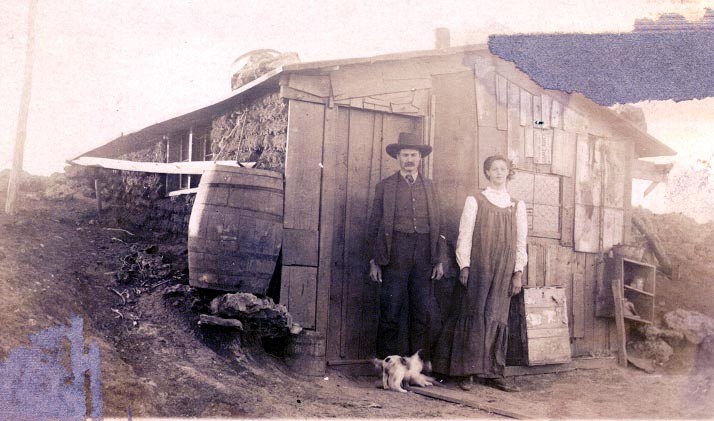|
Moderated by NW Okie! |
Volume 8 , Issue 62006Weekly eZine: (374 subscribers)Subscribe | Unsubscribe Using Desktop... |
Cisterns, Header Barges & Other Memories...

Remember the "Berdie Smelker" sod/dugout photo last weekend? Did you happen to notice the above ground cistern and the wooden gutter that angled down from the back corner of the soddie's roof to the wooden barrel setting at the front corner gathering rain water? Charles Cook submitted that old photo some time back to the Waynoka Historical Society.
Last week I was corrected concerning where we hauled our water from to our ranch north of Waynoka on Highway 14! The cistern water at our ranch 10-miles north of Waynoka came from Waynoka instead of Alva (Oklahoma). It was hauled on the back of a flat bed truck in a tank that leaked so much that it looked as if a road washer was headed up highway 14. And... the cistern water smelled and tasted like cistern water, nothing else like it. I am told that one of the best things that happened to that part of the country was the rural water program.
Let us take a look back to the harvesting and threshing machines of 1914. Back in 1914 harvesting & threshing were two different things. Harvesting consisted of using horses hitched to the back of a cutter and pushing it in the field to cut the wheat.
The header barges consisted of REAL horsepower where two, three or more horses were hitched behind the header barges and then the horses pushed them along the field to cut and create the wheat stacks for the threshing crews. Leaving bulk wheat stacked in the field. When the threshing crew came along later, the bulk wheat stacks were pitched onto the feeder auger to the threshing machine and the straws were exhausted out the long tube to create the famous hay stacks where the cattle kept warm in the winter.
AS to hauling the bushels of wheat to market in 1914... Imagine yourself spending a full day hauling wheat to the grain elevators in town (or wherever) with the help of a horse and wagon only. Not a big semi-truck they use today. AND... only being able to haul 30 bushels at a time. Then... imagine getting 85-cents a bushel. Nowadays, the wheat farmers are lucky if they get over $3.00+ per bushel (net) after paying off their bankers, creditors, and custom harvesters. Those were the days that neighboring farmers and families came together -- helping each other get their harvesting done while the others gathered to feed the harvesting & threshing crews and their animals. Sometimes and mostly to just help out a friend and neighbor. BUT... there were those who were in it for a buck.
If you have not already notice, we are going to try something new here with The OkieLegacy. We want to start featuring individuals family legacies, photos and memories in the main story section -- give them their on by-line. During the beginning of the week we may be sending out little hints to jog your memories -- looking for suggestions from our readers to "Learn & Preserve" our heritage. We want to encourage everyone out there to keep some sort of journal of their family histories for the next generation coming along.
To begin with... let us search, jog your memories for stories of hog butchering time on the farm, milking cows, churning butter, harvesting, threshing, cook shacks, farmers helping farmers unconditionally, etc.
| View or Add Comments (1 Comments)
| Receive
updates ( subscribers) |
Unsubscribe
| © . Linda Mcgill Wagner - began © 1999 Contact Me | |
